 Treating Neurodiversity in Kids will provide concrete osteopathic tools to assess, manage and support children with ASD, ADHD, DCD (Developmental Coordination Disorder), hypotonia, sensory-motor dysfunctions and other neurodevelopmental challenges.
Treating Neurodiversity in Kids will provide concrete osteopathic tools to assess, manage and support children with ASD, ADHD, DCD (Developmental Coordination Disorder), hypotonia, sensory-motor dysfunctions and other neurodevelopmental challenges.
This intensive hybrid course has a strong clinical focus which integrates craniosacral, visceral, myofascial and functional techniques allowing you to confidently assess and manage complex paediatric neurodevelopmental disorders.
Renowned Italian paediatric osteopath Luisa Miraglia will provide up-to-date neurophysiological insights adapted to osteopathic care and explore real cases to give you practical treatment strategies for sensory-motor, autonomic, and craniosacral dysfunctions. She will also outline her collaborative multidisciplinary vision enabling you to work effectively within paediatric care teams.
Combining 4 modules of self-paced, focused online learning, a Q&A follow-up session, clinical case discussions and a day of live hands-on practice, Treating Neurodiversity in Kids gives participants the clinical reasoning, assessment, and treatment skills to address these complex conditions.
Treating Neurodiversity in Kids is open to osteopaths already familiar with craniosacral and visceral techniques. The course has a strong practical focus and includes appropriate manual therapy techniques that you can immediately use with confidence in your practice.
Includes access to 4 modules of pre-learning videos. On the day the course will run from 9AM to 4:30PM. Places are limited to 20 attendees. It also includes morning and afternoon tea, printed course notes and an e-certificate of attendance for your CPD records. The course can be counted as 9 hours CPD.
If you can't decide which of Luisa's Osteo Baby courses to attend we are offering a limited number of discounted places for all 4 dates - Tiny Tummies, Treating Neurodiversity in Kids, Treating Plagiocephaly and Breastfeeding Support. Choose the Osteo Baby series ticket option.
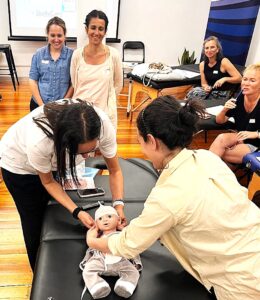 Luisa Miraglia has more than 15 years’ experience practicing as a neonatal and paediatric osteopath. She graduated from Italian College of Osteopathy in Bologna (2009) and completed a Masters in Paediatric Osteopathy at the Osteopathic Centre for Children, Italy (OCC) (2019). Luisa has pursued further training in Europe and the United States, engaging in courses and clinical rotations collaborating with recognised leaders in the paediatric osteopathy field, including Viola Frymann, Jane Carreiro, Hollis King, Stuart Korth, Susan Turner, Nicette Sergueff, among others.
Luisa Miraglia has more than 15 years’ experience practicing as a neonatal and paediatric osteopath. She graduated from Italian College of Osteopathy in Bologna (2009) and completed a Masters in Paediatric Osteopathy at the Osteopathic Centre for Children, Italy (OCC) (2019). Luisa has pursued further training in Europe and the United States, engaging in courses and clinical rotations collaborating with recognised leaders in the paediatric osteopathy field, including Viola Frymann, Jane Carreiro, Hollis King, Stuart Korth, Susan Turner, Nicette Sergueff, among others.
Her teaching experience in extensive, having worked as a teacher and clinical tutor at the OCC, as a paediatric osteopathy instructor at the OSCE school, as educational director and teacher for the Master's degree program in Paediatric Osteopathy at the Fulcro School of Osteopathy (Treviso), and serving as vice president of the Italian Osteopathy Association.
Luisa is very excited to be bringing her Treating Neurodiversity in Kids course to Australia for the first time.
Breastfeeding is a beautiful and natural process, but it is not always without challenges. From latch and suckling difficulties, to milk supply and nipple pain, many parents encounter obstacles along their breastfeeding journey that can lead to frustration and even premature weaning.

Understanding these issues and how they relate to biomechanics, the MSK system, hormones, posture, and other factors is key to supporting your patients.
With the appropriate assessment and treatment techniques for baby’s skull, cervical spine, shoulder dystocia, breathing dynamics, pelvic mechanics and more you’ll be able to help them to embrace the joy of successful breastfeeding.
This in-depth course from highly respected Italian Paediatric Osteopath Luisa Miraglia combines the anatomy and physiology of lactation with case-studies and gentle-but-effective osteopathic assessment and treatment techniques. Breastfeeding Support will deliver you the knowledge and skills to support your patients and improve the health and well-being of both parent and baby.
Techniques will be demonstrated and practiced via a combination of detailed pre-recorded videos, on fellow attendees and a planned infant clinic to end the day. The clinic is dependent on suitable parents volunteering. We will do our best facilitate this aspect of the course but for obvious reasons it cannot be guaranteed.
Breastfeeding Support is open to osteopaths of all levels of experience. The course has a strong practical focus and includes appropriate manual therapy techniques that you can immediately use with confidence in your practice. Best efforts will be made to have infants present but this cannot be guaranteed.
Includes access to around 2 hours of pre-learning videos covering anatomy and other background topics. On the day the course will run from 9AM to 4:30PM. Places are limited to 20 attendees. It also includes morning and afternoon tea, printed course notes and an e-certificate of attendance for your CPD records. The course can be counted as 9 hours CPD.
If you can't decide which of Luisa's Osteo Baby courses to attend we are offering a limited number of discounted places for all 4 dates - Tiny Tummies, Treating Neurodiversity in Kids, Treating Plagiocephaly and Breastfeeding Support. Choose the Osteo Baby series ticket option.
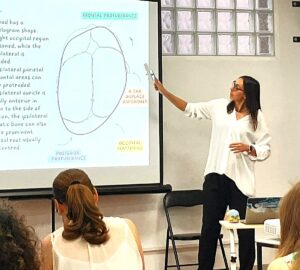 Luisa Miraglia has more than 15 years’ experience practicing as a neonatal and paediatric osteopath. She graduated from Italian College of Osteopathy in Bologna (2009) and completed a Masters in Paediatric Osteopathy at the Osteopathic Centre for Children, Italy (OCC) (2019). Luisa has pursued further training in Europe and the United States, engaging in courses and clinical rotations collaborating with recognised leaders in the paediatric osteopathy field, including Viola Frymann, Jane Carreiro, Hollis King, Stuart Korth, Susan Turner, Nicette Sergueff, among others.
Luisa Miraglia has more than 15 years’ experience practicing as a neonatal and paediatric osteopath. She graduated from Italian College of Osteopathy in Bologna (2009) and completed a Masters in Paediatric Osteopathy at the Osteopathic Centre for Children, Italy (OCC) (2019). Luisa has pursued further training in Europe and the United States, engaging in courses and clinical rotations collaborating with recognised leaders in the paediatric osteopathy field, including Viola Frymann, Jane Carreiro, Hollis King, Stuart Korth, Susan Turner, Nicette Sergueff, among others.
Her teaching experience in extensive, having worked as a teacher and clinical tutor at the OCC, as a paediatric osteopathy instructor at the OSCE school, as educational director and teacher for the Master's degree program in Paediatric Osteopathy at the Fulcro School of Osteopathy (Treviso), and serving as vice president of the Italian Osteopathy Association.
Luisa is very excited to be bringing her Breastfeeding Support course back to Australia.
Babies come in all shapes and sizes, but their little skulls are soft and somewhat moldable making them prone to skull deformations called plagiocephaly (or flat head syndrome).

Plagiocephaly does not affect the development of a baby’s brain, but if not treated it may change their physical appearance by causing uneven growth of their face and head. Fortunately, plagiocephaly responds well to non-surgical treatments but early diagnosis and treatment are very important.
The key to helping these infants is understanding the causes of plagiocephaly, the diagnostic criteria and techniques, and applying a whole-body approach to treatment. By utilising a combination of cranial techniques, gentle manoeuvres for cranial function, addressing musculoskeletal imbalances and considering the impact of soft tissue tension, you will be able to manage challenges and setbacks, helping promote little-ones continued cranial health and development.
This in-depth course from highly respected Italian Paediatric Osteopath Luisa Miraglia combines assessment, treatment planning, case-studies and gentle-but-effective osteopathic assessment and treatment techniques. Treating Plagiocephaly will deliver you the knowledge and skills to support your patients and improve the health and well-being in both the short and longer term.
Techniques will be demonstrated and practiced via a combination of detailed pre-recorded videos, on fellow attendees and a planned infant clinic to end the day. The clinic is dependent on suitable parents volunteering. We will do our best facilitate this aspect of the course but for obvious reasons it cannot be guaranteed.

Treating Plagiocephaly is open to osteopaths of all levels of experience. The course has a strong practical focus and includes appropriate manual therapy techniques that you can immediately use with confidence in your practice. Best efforts will be made to have infants present but this cannot be guaranteed.
Includes access to around 2 hours of pre-learning videos covering anatomy and other background topics. On the day the course will run from 9AM to 4:30PM. Places are limited to 20 attendees. It also includes morning and afternoon tea, printed course notes and an e-certificate of attendance for your CPD records. The course can be counted as 9 hours CPD.
If you can't decide which of Luisa's Osteo Baby courses to attend we are offering a limited number of discounted places for all 4 dates - Tiny Tummies, Treating Neurodiversity in Kids, Treating Plagiocephaly and Breastfeeding Support. Choose the Osteo Baby series ticket option.
 Luisa Miraglia has more than 15 years’ experience practicing as a neonatal and paediatric osteopath. She graduated from Italian College of Osteopathy in Bologna (2009) and completed a Masters in Paediatric Osteopathy at the Osteopathic Centre for Children, Italy (OCC) (2019). Luisa has pursued further training in Europe and the United States, engaging in courses and clinical rotations collaborating with recognised leaders in the paediatric osteopathy field, including Viola Frymann, Jane Carreiro, Hollis King, Stuart Korth, Susan Turner, Nicette Sergueff, among others.
Luisa Miraglia has more than 15 years’ experience practicing as a neonatal and paediatric osteopath. She graduated from Italian College of Osteopathy in Bologna (2009) and completed a Masters in Paediatric Osteopathy at the Osteopathic Centre for Children, Italy (OCC) (2019). Luisa has pursued further training in Europe and the United States, engaging in courses and clinical rotations collaborating with recognised leaders in the paediatric osteopathy field, including Viola Frymann, Jane Carreiro, Hollis King, Stuart Korth, Susan Turner, Nicette Sergueff, among others.
Her teaching experience in extensive, having worked as a teacher and clinical tutor at the OCC, as a paediatric osteopathy instructor at the OSCE school, as educational director and teacher for the Master's degree program in Paediatric Osteopathy at the Fulcro School of Osteopathy (Treviso), and serving as vice president of the Italian Osteopathy Association.
Luisa is very excited to be bringing her Treating Plagiocephaly course back to Australia.
If it’s been a while since you had the privilege of returning to the anatomy laboratory to learn, then you’ll love this event!
Pelvic pain and organ dysfunction is a common presentation - with 1 in 5 women and 1 in 12 men suffering at some time in their life. This sensitive area of practice requires a sound understanding of functional pelvic anatomy, embryology and how this translates to common symptomatology, and individualised treatment.
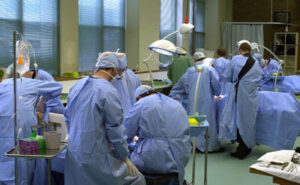
This clinical anatomy course - hosted at the University of Melbourne Cadaver Wet Lab - utilises real cases seen by the interdisciplinary team at the Women’s Health & Research Institute of Australia in Sydney to review the clinical anatomy of pre-dissected pelvic cadavers under the guidance of gynaecological surgeon and pain medicine physician Prof Thierry Vancaillie and advanced pain management osteopath Liz Howard.
These cases will highlight the importance of understanding the complex interrelationship of the pelvic anatomy structures and how this helps us understand patient symptoms.
The day will conclude with a tour of Melbourne Uni’s private Harry Brookes Allen Museum of Anatomy and Pathology - one of Australia's largest collections of human tissue specimens, comparative anatomy specimens and historical anatomical models.
At the end of this workshop you will be able to;
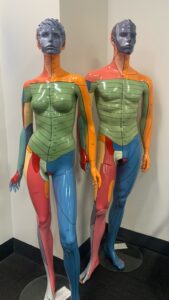 Better visualise the anatomical structures of pelvic anatomy
Better visualise the anatomical structures of pelvic anatomyThis course is applicable to all medical practitioners and allied health with an interest in pelvic anatomy. It would serve as an excellent addition to Pain & Pregnancy, The Pelvic Pain Puzzle and The Endo Enigma courses.
The course will also feature exclusive access to pelvic anatomy, embryology, physiology pre-learning videos (to maximise time in the lab).
The course will run from 8:45AM to 4:30PM. Places are limited to 24 attendees. It includes morning and afternoon tea and an e-certificate of attendance for your CPD records. The course can be counted as 8 hours CPD.
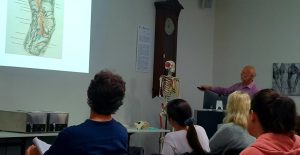
Professor Thierry Vancaillie is one of Australia’s few accredited Gynaecologist and Pain Medicine Physicians, renowned for his role in developing minimally invasive procedures, including hysteroscopic and laparoscopic surgery. His expertise includes pudendal neuralgia, pelvic pain, post-surgical pain due to mesh implants and the surgical treatment of infertility due to Asherman's Syndrome.
Liz Howard has 25 years experience as an osteopath. She holds the title of Advanced Pain Management Osteopath with a Master of Science in Medicine (Pain Mgt) (USYD), she conducts clinical research and is a clinical specialist in sacral neuromodulation. She has more than 17 years’ experience teaching at multiple Australian universities and as a CPD provider. Liz has been working in collaboration with Prof Vancaillie the team at WHRIA for over 10 years, providing osteopathic manual therapy, pain education, exercise and home care advice to help guide patients on their path to recovery, as a part of a whole team approach.
The Women’s Health & Research Institute of Australia (WHRIA) is a tertiary specialist clinic for pelvic and perineal pain, general gynaecology and hormone issues, with referrals for women and men from all over Australia.
Prof is personable, approachable and shares his knowledge with ease. The course content is set at the right level (not too difficult/easy). Liz is a legend - fun, sincere, knowledgeable and keeps bringing examples back to osteo.
Ashar Salia
Hands-on inspection of the dissected anatomy was a great opportunity for a deeper understanding. The expertise of the presenters was very evident and they were excellent at sharing their knowledge.
Robert Gorman, PhD
Was great to review the anatomy of the pelvis then look at the wet specimens in the lab to visualise the diversity between specimens. The Melb Uni anatomy museum was amazing to have access to. Loved Thierry's individual approach to his patients and how holistic his thinking is encompassing a multi-disciplinary approach. Was great to discuss specific case studies to see the variety of presentations and different treatment approaches.
Natasha Rizzi
Liz Howard is one of Australia’s leading Osteopaths with experience in treating the pelvis. Working closely with Pain Physician and Gynaecologist Prof Thierry Vancaillie at the Women’s Health & Research Institute of Australia Liz sees the consequences of difficult births, pregnancies and prolonged labour every day. With the right approach, great clinical results can be achieved for many complex presentations and Liz is passionate about sharing her knowledge and experience in this area.
In Pain & Pregnancy, you’ll learn how to best assist patients prepare for birth as well as post-partum covering topics such as prolapse, diastasis recti, preventing nerve pain, pelvic girdle pain, post-cesarean care, breastfeeding ergonomics, and more.
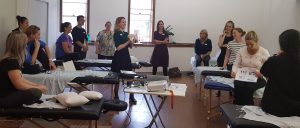 Treatment models, and direct and indirect techniques demonstrated are based on the latest clinical guidelines for reducing pelvic floor delivery trauma, managing pelvic girdle pain, and the prevention of post-partum complications in the short and long term. You will learn useful self-management tips that patients can utilize during pregnancy, in birth-planning and the post-partum period.
Treatment models, and direct and indirect techniques demonstrated are based on the latest clinical guidelines for reducing pelvic floor delivery trauma, managing pelvic girdle pain, and the prevention of post-partum complications in the short and long term. You will learn useful self-management tips that patients can utilize during pregnancy, in birth-planning and the post-partum period.
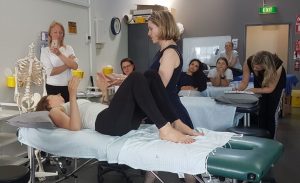
The Pain & Pregnancy course is applicable to all allied health manual therapy practitioners with no prior experience treating pregnancy pain required. It will include practical examination and treatment protocols you will be able to immediately use with confidence in your practice.
The course will run from 8:30 AM to 4 PM. It includes morning and afternoon tea, e-notes and an e-certificate of attendance for your CPD records. The course can be counted as 7 hours CPD.
After completing this course attendees will have the opportunity to attend Liz Howard’s Pelvic Pain Puzzle course which teaches the management of pelvic and perineal pain.
Advanced Pain Management Osteopath Liz Howard practices at the Women's Health & Research Institute of Australia, a specialist pelvic pain clinic in Sydney. She holds a Master of Science in Medicine (Pain Management) from USYD in 2013 and has over 25 years’ of experience as an osteopath, including pain education and as a clinical specialist in sacral neuromodulation.
Liz has more than 16 years’ of experience teaching at Australian universities and as a CPD provider. Her teaching experience ranges from course writing, presenting lectures and practicum in Undergraduate and Master’s Osteopathic programs (University of Western Sydney, Southern Cross University), clinical supervision of Osteopathic students (UWS, SCU, SportsMed Mumbai), to presentations at many professional associations including RANZCOG (Royal Australian & New Zealand College of Obstetrics & Gynaecology), AGES (Australasian Gynaecological Endoscopy & Surgery), NSANZ (Neuromodulation Society of Australia and New Zealand), Osteopathy Australia National Conference presentation, Pregnancy Massage Australia, Pelvic Floor Seminars, GP education evenings and international allied health events, most recently in Ireland, Sweden and New Zealand.
Find out more about Liz Howard's experience here.
Organisation and venue was great which left participants comfortable to concentrate on the excellent delivery of very helpful and relevant information and instruction. Well done everyone involved and a big thank you to Liz for so generously sharing her skill and expertise.
Gopi McLeod
This was hands down one of the best courses I have attended! The balance of updated info, the course structure and the hands on practice was brilliant. I especially enjoyed that you tailored the course to the attendees and the one day course structure so that I don't feel burned out on the weekend and it didn’t impact work as much as a two day course may have. Thank you very much to all of the tutors and Liz for your guidance and support.
Casey Beaumont
Clear instruction, straight to the point, no wasting time.
Leonardo Viola
Colic, constipation, and reflux are common gastrointestinal issues for tiny tummies, causing distress for both babies and parents. They can lead to problems feeding and sleeping, increased crying and fussiness, and affect bonding and overall emotional health. With a comprehensive understanding of these conditions, osteopathy is perfectly placed to help alleviate discomfort and promote better function in infants.
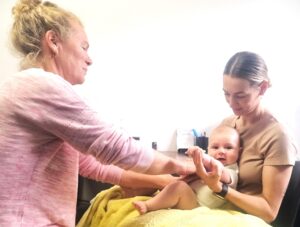
Learn to use your palpation to assess muscle tone, the vertebral column, cranial structures and restriction in the diaphragm, thoracic spine, and abdomen. Then apply safe, gentle infant-specific osteopathic techniques to address cranial restrictions, optimize cerebrospinal fluid dynamics, and enhance vagal tone and digestive function, as well as release tension in the diaphragm, abdominal organs, and pelvic floor, and improve respiratory function.
Along with strategies to improve baby’s posture, feeding patterns, pelvic floor muscle tone and co-ordination, nerve function, cranial/cervical mobility, parasympathetic tone, and mobility and function of the intestines there is so much you can do!
This in-depth course from highly respected Italian Paediatric Osteopath Luisa Miraglia combines assessment, treatment planning, case-studies and gentle-but-effective osteopathic assessment and treatment techniques. Tiny Tummies will deliver you the knowledge and skills to support your patients and improve the health and well-being in both the short and longer term.
Techniques will be demonstrated and practiced via a combination of detailed pre-recorded videos, on fellow attendees and a planned infant clinic to end the day. The clinic is dependent on suitable parents volunteering. We will do our best facilitate this aspect of the course but for obvious reasons it cannot be guaranteed.

Tiny Tummies is open to osteopaths of all levels of experience. The course has a strong practical focus and includes appropriate manual therapy techniques that you can immediately use with confidence in your practice. Best efforts will be made to have infants present but this cannot be guaranteed.
Includes access to around 2 hours of pre-learning videos covering anatomy and other background topics. On the day the course will run from 9AM to 4:30PM. Places are limited to 20 attendees. It also includes morning and afternoon tea, printed course notes and an e-certificate of attendance for your CPD records. The course can be counted as 9 hours CPD.
If you can't decide which of Luisa's Osteo Baby courses to attend we are offering a limited number of discounted places for all 4 dates - Tiny Tummies, Treating Neurodiversity in Kids, Treating Plagiocephaly and Breastfeeding Support. Choose the Osteo Baby series ticket option.
 Luisa Miraglia has more than 15 years’ experience practicing as a neonatal and paediatric osteopath. She graduated from Italian College of Osteopathy in Bologna (2009) and completed a Masters in Paediatric Osteopathy at the Osteopathic Centre for Children, Italy (OCC) (2019). Luisa has pursued further training in Europe and the United States, engaging in courses and clinical rotations collaborating with recognised leaders in the paediatric osteopathy field, including Viola Frymann, Jane Carreiro, Hollis King, Stuart Korth, Susan Turner, Nicette Sergueff, among others.
Luisa Miraglia has more than 15 years’ experience practicing as a neonatal and paediatric osteopath. She graduated from Italian College of Osteopathy in Bologna (2009) and completed a Masters in Paediatric Osteopathy at the Osteopathic Centre for Children, Italy (OCC) (2019). Luisa has pursued further training in Europe and the United States, engaging in courses and clinical rotations collaborating with recognised leaders in the paediatric osteopathy field, including Viola Frymann, Jane Carreiro, Hollis King, Stuart Korth, Susan Turner, Nicette Sergueff, among others.
Her teaching experience in extensive, having worked as a teacher and clinical tutor at the OCC, as a paediatric osteopathy instructor at the OSCE school, as educational director and teacher for the Master's degree program in Paediatric Osteopathy at the Fulcro School of Osteopathy (Treviso), and serving as vice president of the Italian Osteopathy Association.
Luisa is very excited to be bringing her Tiny Tummies course back to Australia for the second time.